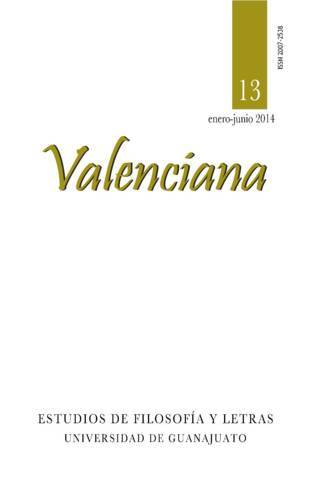El temple de ánimo como horizonte de la reflexión: autoexamen, decisión y consideración emotiva
DOI:
https://doi.org/10.15174/rv.v0i13.46Keywords:
Autoexamen, autoconocimiento, temple de ánimo, consideración emotivaAbstract
El objetivo de este estudio es aclarar la idea de reflexión en el contexto de la explicitación de los horizontes del yo personal y su relación con la noción de “autoexamen”, como meditación sobre la propia vida con su valor concreto. Para ello hacemos un balance de la noción de autoexamen o Selbstbesinnung en diferentes escritos de Husserl con la finalidad de aportar una aclaración que permita comprender un sentido amplio de la reflexión, no necesariamente intelectualista, y su lugar en la idea de autoconocimiento como esclarecimiento del sentido de la vida concreta desde una perspectiva fenomenológica.References
Brough, John B., 2005, “The Emergency of an absolute conscioussness in Husserl´s early writtings on time-consciousness”, en Rudolf Bernet, Donn Welton and Gina Zavota, Edmund Husserl, Critical Assessments of Leading Philosophers, vol. III, Nueva York, Routledge, pp. 247-272.
Dodd, James, 2010, “Death and Time in Husserl´s C-Manuscripts”, en Dieter Lohmar y Ichiro Yamaguchi, On Time. New Contributions to the Husserlian Phenomenology of Time, Springer, Phänomenologica, 197, pp. 51-70.
Gross, Alexis, 2011, “Wilhelm Dilthey y la fundamentación psicologista de las ciencias humanas, en C. B. González y P. Perkins (comps.), Estudios de Fenomenología y Hermenéutica V. Vida y concepto. Conmemorando el centenario de Wilhelm Dilthey (1833-1911), Paraná, Círculo de Fenomenología y Hermenéutica de Santa Fe-Paraná, pp. 7-14.
Husserliana I, 1973, Cartesianische Meditationen und Pariser Vorträge, S. Strasser, (ed.), La Haya, Martinus Nijhoff.
Husserliana III/1, 1977, Ideen zu einer reinen Phänomenologie und phänomenologischen Philosophie. Erstes Buch: Allgemeine Einführungin die reine Phänomenologie 1. Halbband: Text der 1.-3. Auflage — Nachdruck, Karl Schuhmann (ed.), La Haya, Martinus Nijhoff.
Husserliana IV, 1984, Ideen zu einer reinen Phänomenologie und phänomenologischen Philosophie, Zweites Buch: Phänomenologische Untersuchungen zur Konstitution, Marly Biemel (ed.), Kluwer Academic Publishers B.V.
Husserliana Materialien, Band VIII. 2006, Späte Texte über Zeitkonstitution (1929-1934). Die C-Manuskripte, Dieter Lohmar (ed.), Nueva York, Springer.
Manuscritos inéditos estudiados y citados de acuerdo a la ordenación del Archivo Husserl de la Universidad Católica de Lovaina.: Ms. A VI 8 I — II, Ms. A VI 12 I-II, Ms. A VI 34, Ms. E III 4, Ms. E III 6, Ms. M III 3, I-III.
Mezzanzanica, Massimo, 2011, “Philosophie der Erfahrung und Erneuerung des Apriori: Dilthey und Helmholtz”, en Hans-Ulrich, Rudolf A. Makkreel y Riccardo Pozzo (eds.), Recent Contributions to Dilthey Philosophy of the Human Sciences, Stuttgart, Frooman Holzboog Verlag, pp. 59-81.
Schumman, Karl, 1997, Husserl-Cronik, Denk- und Lebensweg Edmund Husserls, Husserliana Dokumente 1, La Haya, Martinus Nijoff.
Taylor, Charles, 2006, Las fuentes del yo, Ana Lizón (trad.), Barcelona, Paidós.
Walton Roberto, 2004, “Horizonticidad y Juicio”, Anuario Filosófico XXXVII/I, núm. 78, pp. 197-242.
Zirión, Antonio, 2009, “El resplandor de la afectividad”, en Acta Fenomenológica Latinoamericana, v. III, Morelia, Círculo Latinoamericano de Fenomenología, PUCP-UMSNH.
Published
How to Cite
Issue
Section
License
Author(s) who publish in this journal do accept the next conditions:
According to copyright regulations, Valenciana does recognize and respect the authors’ moral right, as well as the right of property, which will be assigned to the journal for its diffusion in open access.
Valenciana does not charge authors for the submission, editorial process or publication in the journal.
All texts published and distributed by Valenciana (without exception) are supported by the license Creative Commons Attribution-NonCommercial 4.0 International (CC BY-NC 4.0), which allows third parties to use the publication as long as they mention the author and the first publication.
Authors can make other independent and additional contractual agreements for the non-exclusive use of his article published in Valenciana (e.g. including it in an institutional repository or in printed/electronic media), as long as it is explicitly clarified that the article was published for the first time in this journal.
For these purposes, authors must sign and send the letter of submission and copyright transfer form in a PDF file to this email address: revistavalenciana@gmail.com
This journal is under a license by Creative Commons Atribución-NoComercial-SinDerivadas 4.0 Internacional (CC BY-NC-ND 4.0)).











